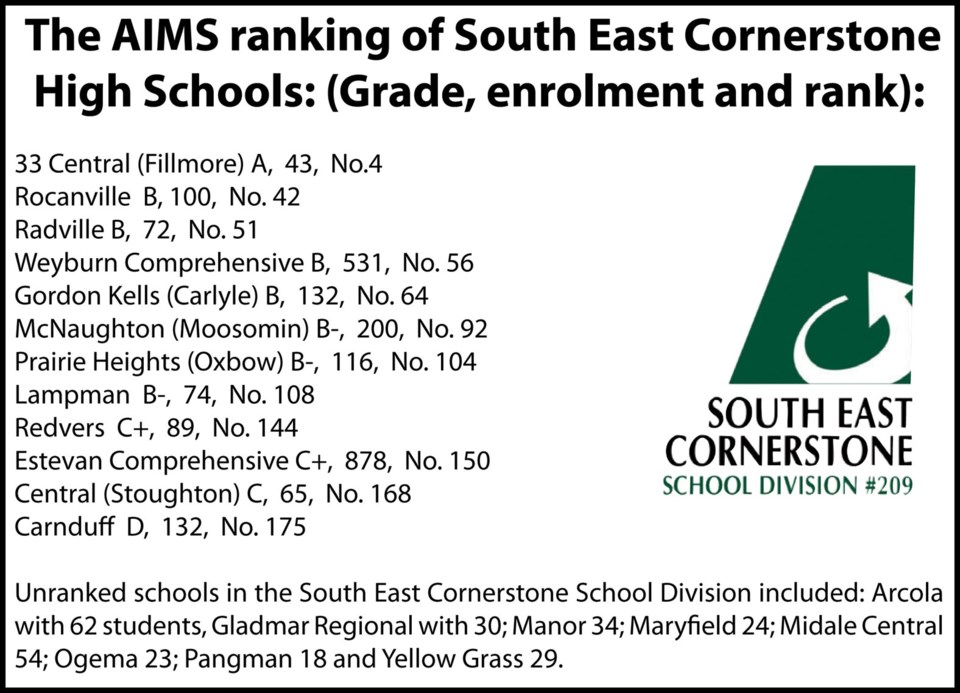The report card on Saskatchewan's high schools was released last week and it suggested that the Estevan Comprehensive School had a lot of extra homework to do, giving the province's 15th largest high school a grading of C+. The rating system used placed the Estevan educational facility at No. 150 out of the 178 high schools that were ranked by the Atlantic Institute for Market Studies (AIMS) in partnership with the Frontier Centre for Public Policy.
But before anyone got too excited over the rankings, Marc Casavant, the South East Cornerstone School Division's director of education, issued a statement that suggested the AIMS data was only taken from a small core of information that was gathered by the Ministry of Education.
"They were very selective in the data they chose whereas the core indicators we have gathered from our data days programs shows us much more," said Casavant.
The director also noted that the data used for the AIMS survey was three to five years old.
Casavant stopped short of dismissing the report altogether, and noted that it was just one of many for ECS and other educational centres that had to be treated with a healthy dose of skepticism.
The AIMS report indicated that Englefeld High School was the highest rated secondary school. Englefeld has 40 high school students.
The highest ranking school in the Cornerstone School Division, according to AIMS was 33 Central in Fillmore, rated at No. 4 with a grading of A for its 43 high school students.
It was interesting to note that the top 12 high schools in the AIMS Saskatchewan report all had enrolments of less than 100.
The 11 other South East Cornerstone high schools that were ranked ranged between No. 42 and No. 175. Another eight were unranked by the study group.
"I know the minister of education is pretty well downplaying the report as is the Saskatchewan Teachers' Federation," said Casavant, while acknowledging that the report received a good deal of attention since it was the first time a grading system had been used to attempt to rank the quality of Saskatchewan's educational institutions.
"I do believe they've painted only part of the entire picture. They painted what they wanted to paint and when they were finished, it wasn't a complete picture at all because of the very small data set," said Casavant. He added though, that "we look at it with our lens and certainly we see where incremental changes can be made to help every school get even better. With our continuous improvement framework, we can work on it and we welcome any data, and at the same time we can also scrutinize their program."
Casavant went on to say that schools like ECS were obviously penalized for the huge diversity of their programming.
"The survey only looked at two or three criteria and that included graduation rates and post-secondary moves. But there was no consideration of economic and social data. When you graduate from ECS and you're offered a job in the oil patch at $60,000 a year, you might just take it rather than head off to university right away. That's just one small example," said Casavant, in explaining how a small data set can skewer the rankings.
"Let's look at ECS in particular. This school has a particularly strong professional/career development program. Look at the success rate in the Skills Canada competitions. They finish in the top three every year, that's impressive. C'mon, what's better than that! ECS has lots of high end students and staff with huge success rates that weren't even considered within this survey because of its narrowness. Put it this way, I'll match the public education system in Estevan with anything else in the province and it will do great," said Casavant.
While the AIMS survey provided B- and B+ ratings for mathematics and science studies at ECS, they rated the language arts program at a lower level, and Casavant again noted that special programming and projects that catered to higher achieving students may not have even been considered within the AIMS framework.
Some additional information that came from the study did prove interesting.
For instance, the largest high school in Saskatchewan in terms of enrolment is Prince Albert's Carlton High School with a student population of 2,031, which was well ahead of the second largest school, Walter Murray Collegiate in Saskatoon with their 1,412 students. Carlton was ranked 44th in the AIMS report while Walter Murray stood at 96.
The third and fourth largest high schools in Saskatchewan are Campbell Collegiate in Regina with 1,370 students and Holy Cross in Saskatoon, a Roman Catholic Separate High School with 1,350 enrolled.
The AIMS ranking of South East Cornerstone High Schools: (Grade, enrolment and rank):
33 Central (Fillmore) A, 43, No.4
Rocanville B, 100, No. 42
Radville B, 72, No. 51
Weyburn Comprehensive B, 531, No. 56
Gordon Kells (Carlyle) B, 132, No. 64
McNaughton (Moosomin) B-, 200, No. 92
Prairie Heights (Oxbow) B-, 116, No. 104
Lampman B-, 74, No. 108
Redvers C+, 89, No. 144
Estevan Comprehensive C+, 878, No. 150
Central (Stoughton) C, 65, No. 168
Carnduff D, 132, No. 175
Unranked schools in the South East Cornerstone School Division included: Arcola with 62 students, Gladmar Regional with 30; Manor 34; Maryfield 24; Midale Central 54; Ogema 23; Pangman 18 and Yellow Grass 29.



